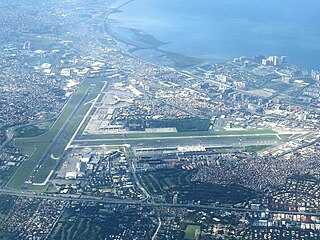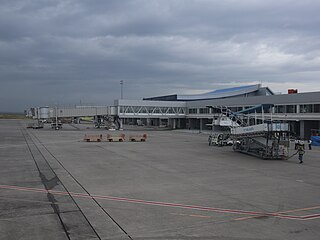Daniel Z. Romualdez Airport Luparan han Daniel Z. Romualdez Paliparan ng Daniel Z. Romualdez | |||||||||||
|---|---|---|---|---|---|---|---|---|---|---|---|
 Exterior of Daniel Z. Romualdez Airport as of 2023. | |||||||||||
| Summary | |||||||||||
| Airport type | Public | ||||||||||
| Owner/Operator | Civil Aviation Authority of the Philippines | ||||||||||
| Serves | Tacloban | ||||||||||
| Elevation AMSL | 3 m / 10 ft | ||||||||||
| Coordinates | 11°13′39″N125°01′40″E / 11.22750°N 125.02778°E | ||||||||||
| Map | |||||||||||
| Runways | |||||||||||
| |||||||||||
| Statistics (2022) | |||||||||||
| |||||||||||
Source: CAAP [1] | |||||||||||
Daniel Z. Romualdez Airport( IATA : TAC, ICAO : RPVA), also known as Tacloban City Airport, is an airport serving the general area of Tacloban, a highly urbanized city in the Leyte island of the Philippines. It is the main gateway from Manila and Cebu to Eastern Visayas. It is classified as a Class 1 principal (major domestic) airport by the Civil Aviation Authority of the Philippines. In 2022, Daniel Z. Romualdez Airport served 1.48 million passengers, making it the seventh-busiest in the country.
Contents
- History
- During World War II
- Devastation by Typhoon Haiyan and contemporary history
- Expansion and future development
- Structure
- Passenger terminal
- Runway
- Other structures
- Ground transportation
- Airlines and destinations
- Statistics
- Accidents and incidents
- See also
- References
- External links
The airport is named after Daniel Z. Romualdez, a former speaker of the House of Representatives of the Philippines. It is one of two airports in the Philippines named after a member of the Romualdez family, the other being Imelda R. Marcos Airport in Mati after Imelda Romualdez-Marcos, the wife of the late president Ferdinand Marcos.
On November 8, 2013, the airport was largely destroyed due to the onslaught of Typhoon Haiyan. [2] On January 17, 2015, Pope Francis celebrated Mass at the airport as part of his pastoral and state visit to the country. [3] [4]

























